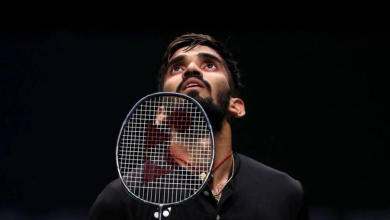World Chess Championship: Of knights facing sideways, a game of chairs and power-walking contenders

Russia’s Ian Nepomniachtchi claimed victory in Game 2 of the World Chess Championship after 29 moves as he forced Ding Liren to resign with the Chinese under the pressure on the board and on the clock.
Unlike the first game, Game 2 packed quite a few surprises. The first one, at least for FIDE commentators Viswanathan Anand and eight-time US Women’s Champion Irina Krush, was the fact that Ding is a “sideways knight” player (a player who has their horse-shaped knight pointing sideways rather than facing the opponents’ pieces).
“I didn’t even realise that (keeping the knight facing) sideways was an option! Have you ever seen a horse facing sideways to its own army? It’s got to face the other one right? It’s got to charge that way? But yeah, Garry (Kasparov) would always turn it sideways,” said Anand at the start of the game.
The surprises didn’t end there. On move 4, Ding moved his pawn to h3, and immediately elicited reactions from everyone including Anand and Krush.
“WOW! Is that pawn to h3?” – Irina Krush
Irina Krush on an extremely rare choice so early in the game, on the 4th move; and it seems to have surprised, apart from Irina, also Ian Nepomniachtchi. #NepoDing pic.twitter.com/p6vNezJFVk
— International Chess Federation (@FIDE_chess) April 10, 2023
https://platform.twitter.com/widgets.js
Even Nepo was taken aback the move. His immediate reaction was his eyebrows shooting up and the shadow of a smile appearing on his face. He slowly chugged his water and swiveled on his chair on the stage thinking about the next move for 10 minutes.
“I had a feeling that the move had some influence of Richard (Rapport). It is a little bit of a tricky move. It could turn to be very venomous. I don’t know if the move was good or bad,” said Nepo in the post-match press conference.
Ding admitted that the “very rare” h3 move had indeed been the idea of his second, Rapport. News of the Hungarian GM joining the Chinese player’s team for the World Championship had also caused a shock, as he had competed in the Candidates Tournament against Nepo and Ding.
Russian GM Alexander Shabalov, who is in Astana to do commentary in Russian, said: “The main idea there was to take Ian out of the book. But Ian’s reaction was absolutely amazing, he played in the most aggressive way,” he said.
Game of chairs
Before the Worlds started, FIDE, the global governing body for chess, had posted a clip on its Twitter handle of Ding trying out multiple chairs before selecting one. It’s another matter that he spent more time inside his private lounge than on the chair in both games.
But the choice of chairs has raised quite some interest, particularly because most of the previous world championships were played with both players getting the same chairs. Not this time around though: as Russian media organisations have noted, Nepo is using a black leather chair which is an Eames Time Life chair. Russian media has quoted Sergey Kishnev, who has helped Nepo for this contest, saying that it is the same chair used American Bob Fischer when he beat USSR’s Boris Spassky in 1972 to end Soviet dominance of the World Championship.
When asked, Nepo just shrugged and said: “One day, I just felt myself too lazy to go to some furniture mall to check some options. I knew there is a nice one, so I just decided, let’s pick this one.”
Talking about chairs and the “tradition” around them, Anand said: “In the first Candidates match I played with Alexey Dreev in 1991, it was happening in Chennai, my hometown. All of this was fairly new to me. Dreev came down and he and his team inspected the chair, sat down, said this is comfortable, this is not comfy. They also inspected the lighting in the arena and said the light is not clear, it’s the wrong colour. The tablecloth is glaring… I really couldn’t tell if they were just joking around or were serious. But later I realised that this is part of the ritual.”
Gone in blink of an eye
Throughout the game – or at least until he ran into time trouble and, at one stage, needed to make 15 moves with four minutes on the clock – Ding preferred to barricade himself into his own private lounge for large chunks of the game watching the action on the stage from a safe dance. Once on stage, he would quickly make his move and walk off, probably to avoid spending too much time in the glare of the open stage area with his Russian opponent across the board.
In the 12th move, Ding took a long time to get out of his comfy-looking seat in the lounge. Once he did, he almost power-walked his way to the stage. And then sat rooted on hsi seat staring at the board like a schoolkid contemplating a particularly vexing algebra problem. Once he finally made his move after almost 40 minutes, he rushed away from the stage again. In complete contrast, Nepo walked in like he was in the midst of a particularly relaxing evening stroll on the beach.
“If we can arrange a mouse in Ding’s cabin, he could just play from there,” joked Anand.
Seeing both players spend so much time in their lounges, GM Susan Polgar tweeted that she found it annoying. “The players are almost never at the board at the same time. Too much time spent in their personal areas. The fans around the world are tuning in to literally see two empty chairs.”
In the press conference Nepo was asked whether the image of an empty chessboard for large parts of the World Championship is good for the sport.
“Staying in the room to think reminds me of the COVID days of playing chess. Online times. If it’s comfortable to think in the room, it’s comfortable to think in the room. There shouldn’t be any restriction,” said the Russian.
He went on to add that he had also spent a lot of time in the room during games of the Dubai World Championship in 2021.
“But that was because I was eating a lot in there. Had a lot of snacks there. I couldn’t part ways with my snacks,” he joked, allowing himself the luxury of a smile.







